BP310: Fashion Rental and Sustainability Research Proposal
VerifiedAdded on 2023/01/19
|22
|5916
|68
Report
AI Summary
This research proposal examines the burgeoning trend of fashion rental within the context of environmental sustainability. The study begins with an abstract that highlights the detrimental effects of fast fashion, from water-intensive cotton production to the pollution caused by textile manufacturing. The introduction underscores the rapid shifts in fashion trends and the rise of rental services as a potential solution, while also acknowledging the historical context of rental models. The rationale of the research emphasizes the environmental concerns associated with clothing waste and the potential of rental services to mitigate these impacts. The research objectives aim to identify the environmental consequences of rental clothing, analyze its negative impacts, and recommend strategies to enhance sustainability within the industry. A comprehensive literature review explores the concepts of sustainability and fast fashion, the environmental issues caused by fast fashion, and the development of the fashion rental business model as a closed-loop system. The methodology section outlines the research philosophy, design, data collection methods, and ethical considerations, along with the limitations of the study. The conclusion will synthesize the research findings and offer insights into the future of fashion rental and its role in promoting environmental responsibility. The references section provides a list of the sources consulted throughout the research.
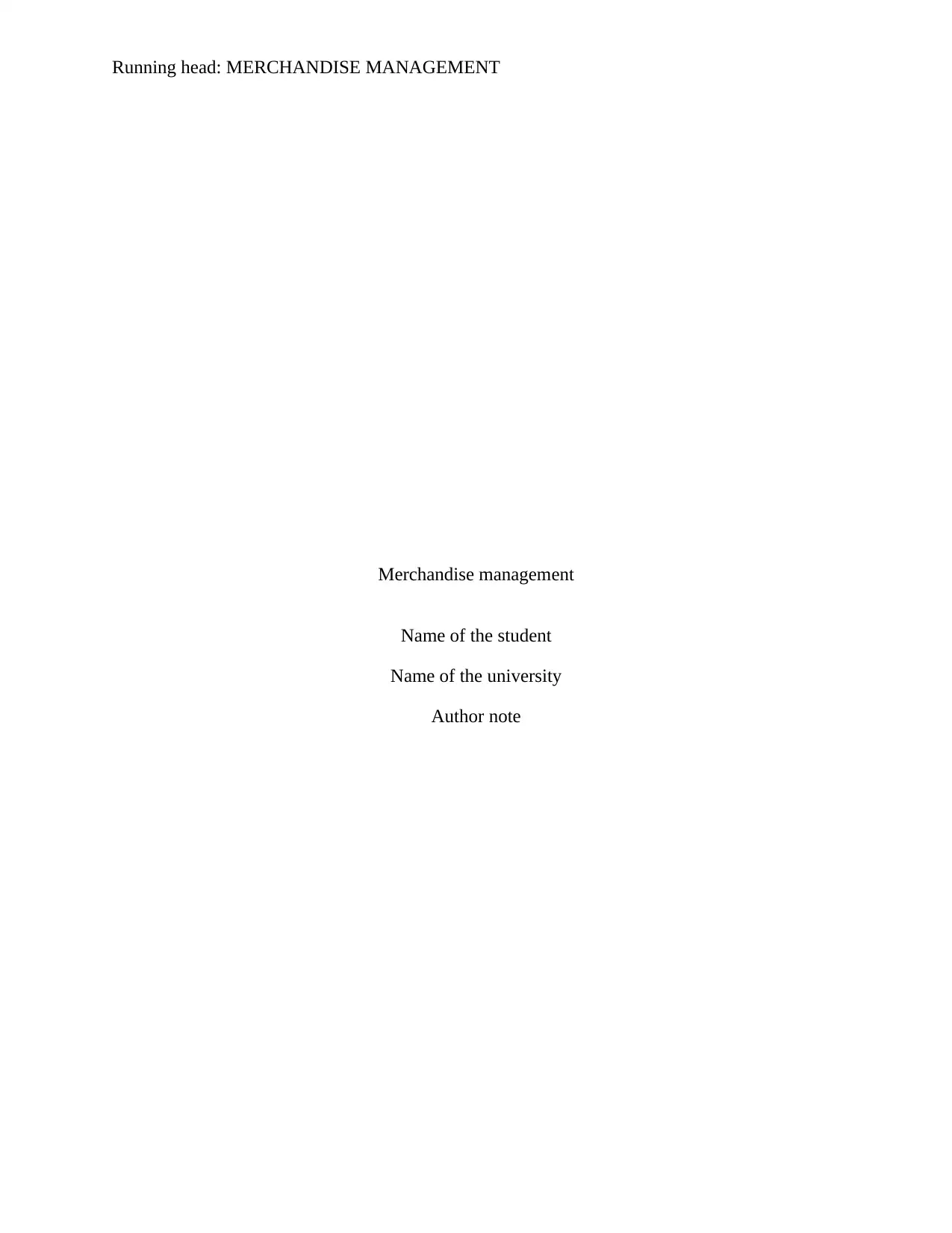
Running head: MERCHANDISE MANAGEMENT
Merchandise management
Name of the student
Name of the university
Author note
Merchandise management
Name of the student
Name of the university
Author note
Paraphrase This Document
Need a fresh take? Get an instant paraphrase of this document with our AI Paraphraser
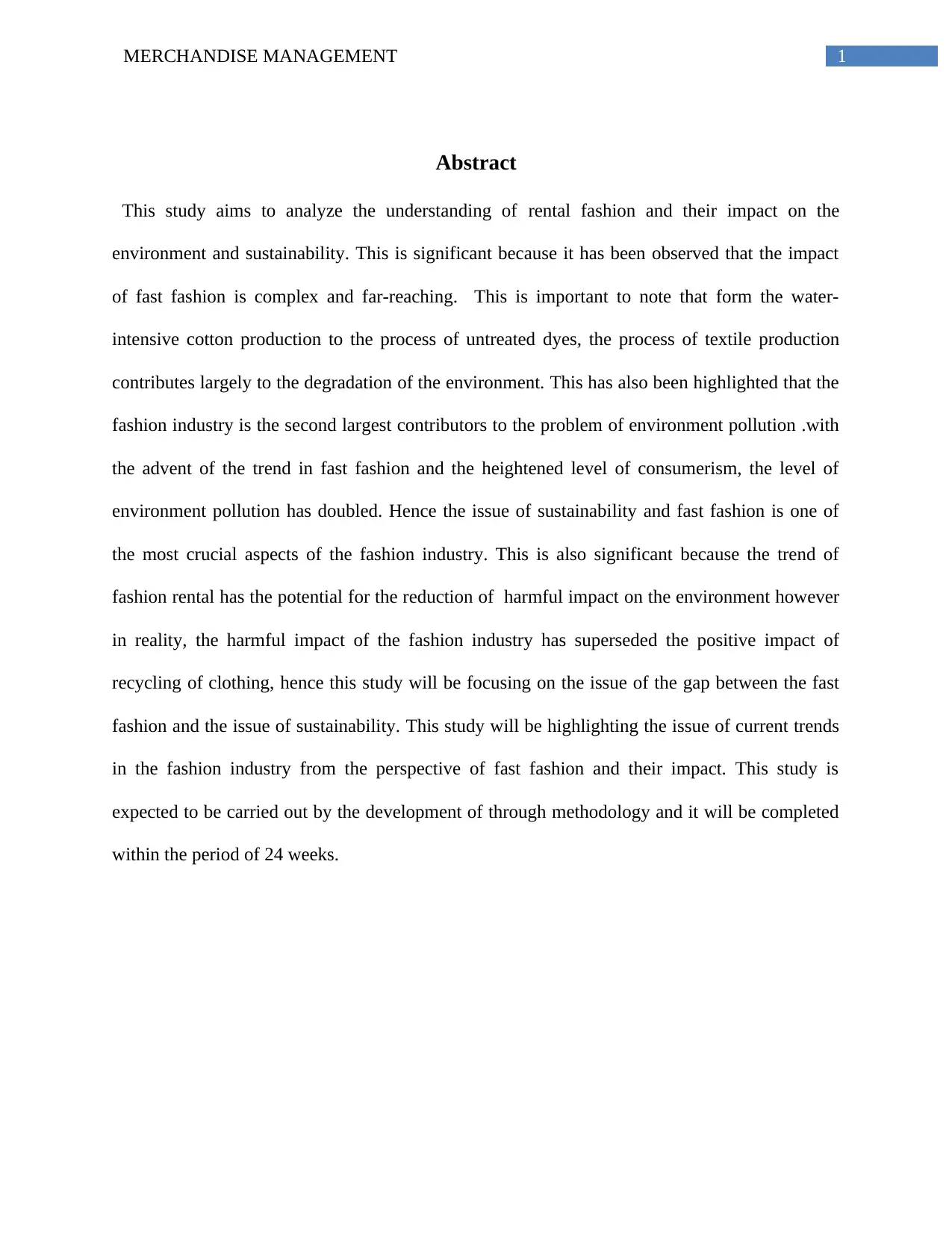
1MERCHANDISE MANAGEMENT
Abstract
This study aims to analyze the understanding of rental fashion and their impact on the
environment and sustainability. This is significant because it has been observed that the impact
of fast fashion is complex and far-reaching. This is important to note that form the water-
intensive cotton production to the process of untreated dyes, the process of textile production
contributes largely to the degradation of the environment. This has also been highlighted that the
fashion industry is the second largest contributors to the problem of environment pollution .with
the advent of the trend in fast fashion and the heightened level of consumerism, the level of
environment pollution has doubled. Hence the issue of sustainability and fast fashion is one of
the most crucial aspects of the fashion industry. This is also significant because the trend of
fashion rental has the potential for the reduction of harmful impact on the environment however
in reality, the harmful impact of the fashion industry has superseded the positive impact of
recycling of clothing, hence this study will be focusing on the issue of the gap between the fast
fashion and the issue of sustainability. This study will be highlighting the issue of current trends
in the fashion industry from the perspective of fast fashion and their impact. This study is
expected to be carried out by the development of through methodology and it will be completed
within the period of 24 weeks.
Abstract
This study aims to analyze the understanding of rental fashion and their impact on the
environment and sustainability. This is significant because it has been observed that the impact
of fast fashion is complex and far-reaching. This is important to note that form the water-
intensive cotton production to the process of untreated dyes, the process of textile production
contributes largely to the degradation of the environment. This has also been highlighted that the
fashion industry is the second largest contributors to the problem of environment pollution .with
the advent of the trend in fast fashion and the heightened level of consumerism, the level of
environment pollution has doubled. Hence the issue of sustainability and fast fashion is one of
the most crucial aspects of the fashion industry. This is also significant because the trend of
fashion rental has the potential for the reduction of harmful impact on the environment however
in reality, the harmful impact of the fashion industry has superseded the positive impact of
recycling of clothing, hence this study will be focusing on the issue of the gap between the fast
fashion and the issue of sustainability. This study will be highlighting the issue of current trends
in the fashion industry from the perspective of fast fashion and their impact. This study is
expected to be carried out by the development of through methodology and it will be completed
within the period of 24 weeks.
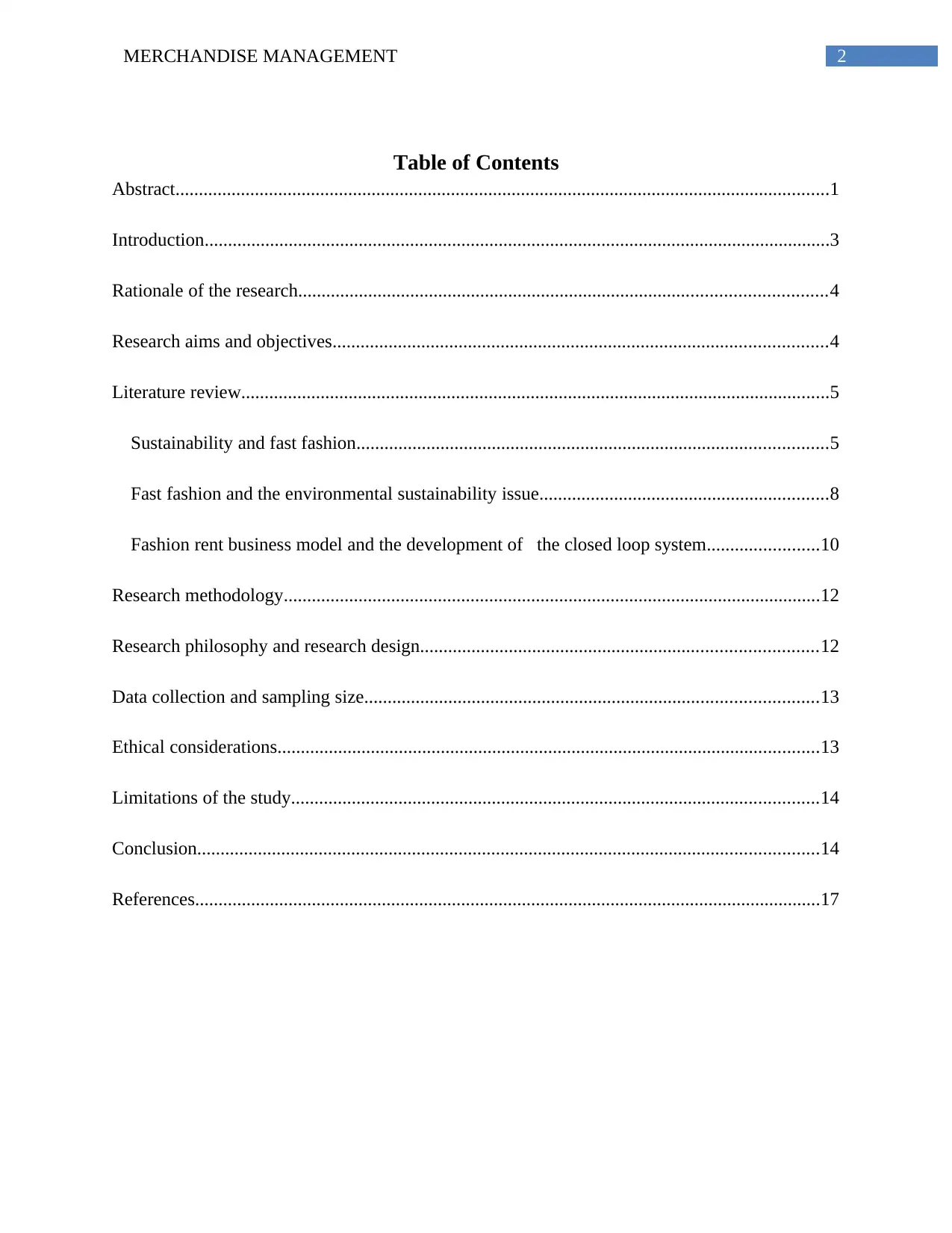
2MERCHANDISE MANAGEMENT
Table of Contents
Abstract............................................................................................................................................1
Introduction......................................................................................................................................3
Rationale of the research.................................................................................................................4
Research aims and objectives..........................................................................................................4
Literature review..............................................................................................................................5
Sustainability and fast fashion.....................................................................................................5
Fast fashion and the environmental sustainability issue..............................................................8
Fashion rent business model and the development of the closed loop system........................10
Research methodology...................................................................................................................12
Research philosophy and research design.....................................................................................12
Data collection and sampling size.................................................................................................13
Ethical considerations....................................................................................................................13
Limitations of the study.................................................................................................................14
Conclusion.....................................................................................................................................14
References......................................................................................................................................17
Table of Contents
Abstract............................................................................................................................................1
Introduction......................................................................................................................................3
Rationale of the research.................................................................................................................4
Research aims and objectives..........................................................................................................4
Literature review..............................................................................................................................5
Sustainability and fast fashion.....................................................................................................5
Fast fashion and the environmental sustainability issue..............................................................8
Fashion rent business model and the development of the closed loop system........................10
Research methodology...................................................................................................................12
Research philosophy and research design.....................................................................................12
Data collection and sampling size.................................................................................................13
Ethical considerations....................................................................................................................13
Limitations of the study.................................................................................................................14
Conclusion.....................................................................................................................................14
References......................................................................................................................................17
⊘ This is a preview!⊘
Do you want full access?
Subscribe today to unlock all pages.

Trusted by 1+ million students worldwide
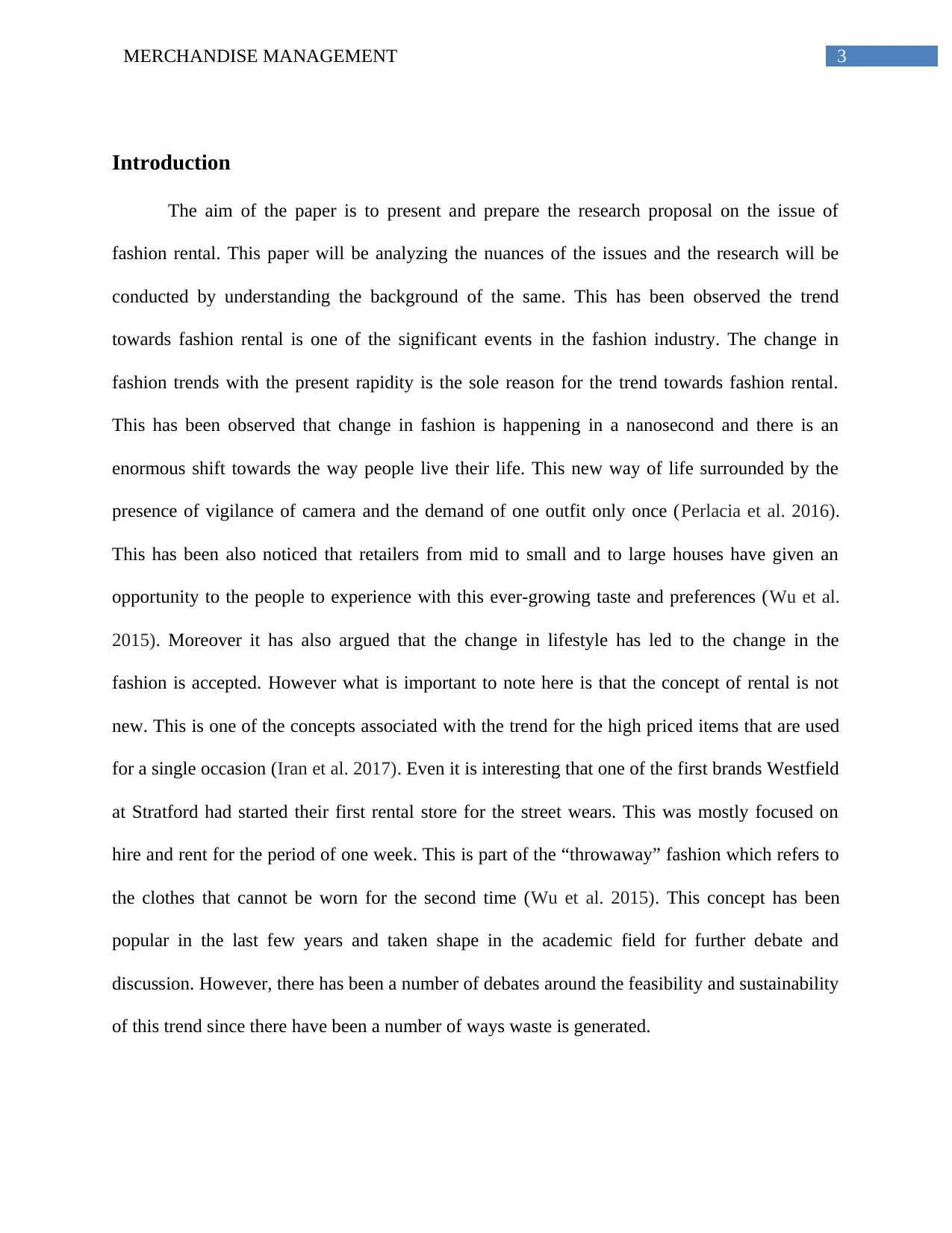
3MERCHANDISE MANAGEMENT
Introduction
The aim of the paper is to present and prepare the research proposal on the issue of
fashion rental. This paper will be analyzing the nuances of the issues and the research will be
conducted by understanding the background of the same. This has been observed the trend
towards fashion rental is one of the significant events in the fashion industry. The change in
fashion trends with the present rapidity is the sole reason for the trend towards fashion rental.
This has been observed that change in fashion is happening in a nanosecond and there is an
enormous shift towards the way people live their life. This new way of life surrounded by the
presence of vigilance of camera and the demand of one outfit only once (Perlacia et al. 2016).
This has been also noticed that retailers from mid to small and to large houses have given an
opportunity to the people to experience with this ever-growing taste and preferences (Wu et al.
2015). Moreover it has also argued that the change in lifestyle has led to the change in the
fashion is accepted. However what is important to note here is that the concept of rental is not
new. This is one of the concepts associated with the trend for the high priced items that are used
for a single occasion (Iran et al. 2017). Even it is interesting that one of the first brands Westfield
at Stratford had started their first rental store for the street wears. This was mostly focused on
hire and rent for the period of one week. This is part of the “throwaway” fashion which refers to
the clothes that cannot be worn for the second time (Wu et al. 2015). This concept has been
popular in the last few years and taken shape in the academic field for further debate and
discussion. However, there has been a number of debates around the feasibility and sustainability
of this trend since there have been a number of ways waste is generated.
Introduction
The aim of the paper is to present and prepare the research proposal on the issue of
fashion rental. This paper will be analyzing the nuances of the issues and the research will be
conducted by understanding the background of the same. This has been observed the trend
towards fashion rental is one of the significant events in the fashion industry. The change in
fashion trends with the present rapidity is the sole reason for the trend towards fashion rental.
This has been observed that change in fashion is happening in a nanosecond and there is an
enormous shift towards the way people live their life. This new way of life surrounded by the
presence of vigilance of camera and the demand of one outfit only once (Perlacia et al. 2016).
This has been also noticed that retailers from mid to small and to large houses have given an
opportunity to the people to experience with this ever-growing taste and preferences (Wu et al.
2015). Moreover it has also argued that the change in lifestyle has led to the change in the
fashion is accepted. However what is important to note here is that the concept of rental is not
new. This is one of the concepts associated with the trend for the high priced items that are used
for a single occasion (Iran et al. 2017). Even it is interesting that one of the first brands Westfield
at Stratford had started their first rental store for the street wears. This was mostly focused on
hire and rent for the period of one week. This is part of the “throwaway” fashion which refers to
the clothes that cannot be worn for the second time (Wu et al. 2015). This concept has been
popular in the last few years and taken shape in the academic field for further debate and
discussion. However, there has been a number of debates around the feasibility and sustainability
of this trend since there have been a number of ways waste is generated.
Paraphrase This Document
Need a fresh take? Get an instant paraphrase of this document with our AI Paraphraser
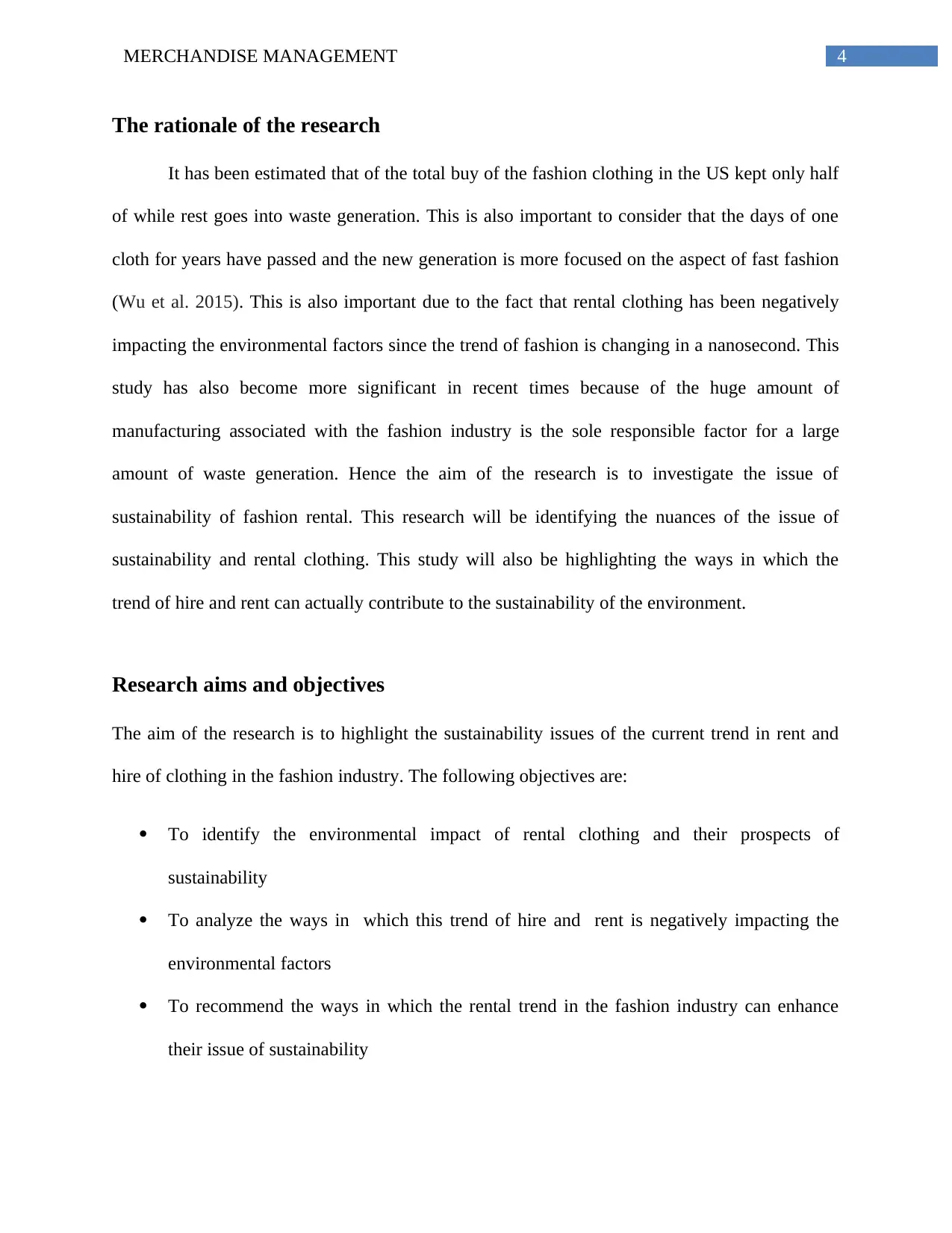
4MERCHANDISE MANAGEMENT
The rationale of the research
It has been estimated that of the total buy of the fashion clothing in the US kept only half
of while rest goes into waste generation. This is also important to consider that the days of one
cloth for years have passed and the new generation is more focused on the aspect of fast fashion
(Wu et al. 2015). This is also important due to the fact that rental clothing has been negatively
impacting the environmental factors since the trend of fashion is changing in a nanosecond. This
study has also become more significant in recent times because of the huge amount of
manufacturing associated with the fashion industry is the sole responsible factor for a large
amount of waste generation. Hence the aim of the research is to investigate the issue of
sustainability of fashion rental. This research will be identifying the nuances of the issue of
sustainability and rental clothing. This study will also be highlighting the ways in which the
trend of hire and rent can actually contribute to the sustainability of the environment.
Research aims and objectives
The aim of the research is to highlight the sustainability issues of the current trend in rent and
hire of clothing in the fashion industry. The following objectives are:
To identify the environmental impact of rental clothing and their prospects of
sustainability
To analyze the ways in which this trend of hire and rent is negatively impacting the
environmental factors
To recommend the ways in which the rental trend in the fashion industry can enhance
their issue of sustainability
The rationale of the research
It has been estimated that of the total buy of the fashion clothing in the US kept only half
of while rest goes into waste generation. This is also important to consider that the days of one
cloth for years have passed and the new generation is more focused on the aspect of fast fashion
(Wu et al. 2015). This is also important due to the fact that rental clothing has been negatively
impacting the environmental factors since the trend of fashion is changing in a nanosecond. This
study has also become more significant in recent times because of the huge amount of
manufacturing associated with the fashion industry is the sole responsible factor for a large
amount of waste generation. Hence the aim of the research is to investigate the issue of
sustainability of fashion rental. This research will be identifying the nuances of the issue of
sustainability and rental clothing. This study will also be highlighting the ways in which the
trend of hire and rent can actually contribute to the sustainability of the environment.
Research aims and objectives
The aim of the research is to highlight the sustainability issues of the current trend in rent and
hire of clothing in the fashion industry. The following objectives are:
To identify the environmental impact of rental clothing and their prospects of
sustainability
To analyze the ways in which this trend of hire and rent is negatively impacting the
environmental factors
To recommend the ways in which the rental trend in the fashion industry can enhance
their issue of sustainability
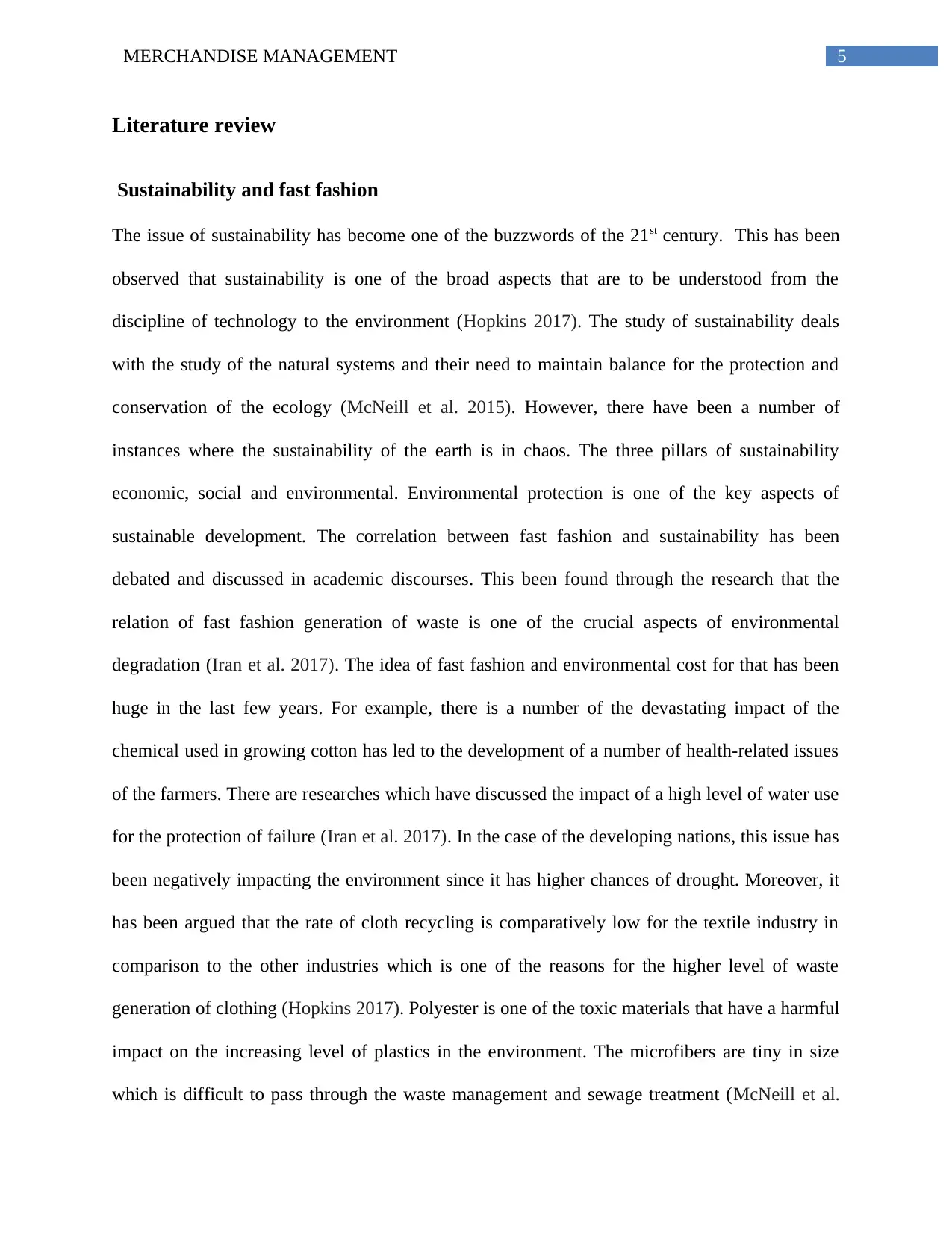
5MERCHANDISE MANAGEMENT
Literature review
Sustainability and fast fashion
The issue of sustainability has become one of the buzzwords of the 21st century. This has been
observed that sustainability is one of the broad aspects that are to be understood from the
discipline of technology to the environment (Hopkins 2017). The study of sustainability deals
with the study of the natural systems and their need to maintain balance for the protection and
conservation of the ecology (McNeill et al. 2015). However, there have been a number of
instances where the sustainability of the earth is in chaos. The three pillars of sustainability
economic, social and environmental. Environmental protection is one of the key aspects of
sustainable development. The correlation between fast fashion and sustainability has been
debated and discussed in academic discourses. This been found through the research that the
relation of fast fashion generation of waste is one of the crucial aspects of environmental
degradation (Iran et al. 2017). The idea of fast fashion and environmental cost for that has been
huge in the last few years. For example, there is a number of the devastating impact of the
chemical used in growing cotton has led to the development of a number of health-related issues
of the farmers. There are researches which have discussed the impact of a high level of water use
for the protection of failure (Iran et al. 2017). In the case of the developing nations, this issue has
been negatively impacting the environment since it has higher chances of drought. Moreover, it
has been argued that the rate of cloth recycling is comparatively low for the textile industry in
comparison to the other industries which is one of the reasons for the higher level of waste
generation of clothing (Hopkins 2017). Polyester is one of the toxic materials that have a harmful
impact on the increasing level of plastics in the environment. The microfibers are tiny in size
which is difficult to pass through the waste management and sewage treatment (McNeill et al.
Literature review
Sustainability and fast fashion
The issue of sustainability has become one of the buzzwords of the 21st century. This has been
observed that sustainability is one of the broad aspects that are to be understood from the
discipline of technology to the environment (Hopkins 2017). The study of sustainability deals
with the study of the natural systems and their need to maintain balance for the protection and
conservation of the ecology (McNeill et al. 2015). However, there have been a number of
instances where the sustainability of the earth is in chaos. The three pillars of sustainability
economic, social and environmental. Environmental protection is one of the key aspects of
sustainable development. The correlation between fast fashion and sustainability has been
debated and discussed in academic discourses. This been found through the research that the
relation of fast fashion generation of waste is one of the crucial aspects of environmental
degradation (Iran et al. 2017). The idea of fast fashion and environmental cost for that has been
huge in the last few years. For example, there is a number of the devastating impact of the
chemical used in growing cotton has led to the development of a number of health-related issues
of the farmers. There are researches which have discussed the impact of a high level of water use
for the protection of failure (Iran et al. 2017). In the case of the developing nations, this issue has
been negatively impacting the environment since it has higher chances of drought. Moreover, it
has been argued that the rate of cloth recycling is comparatively low for the textile industry in
comparison to the other industries which is one of the reasons for the higher level of waste
generation of clothing (Hopkins 2017). Polyester is one of the toxic materials that have a harmful
impact on the increasing level of plastics in the environment. The microfibers are tiny in size
which is difficult to pass through the waste management and sewage treatment (McNeill et al.
⊘ This is a preview!⊘
Do you want full access?
Subscribe today to unlock all pages.

Trusted by 1+ million students worldwide
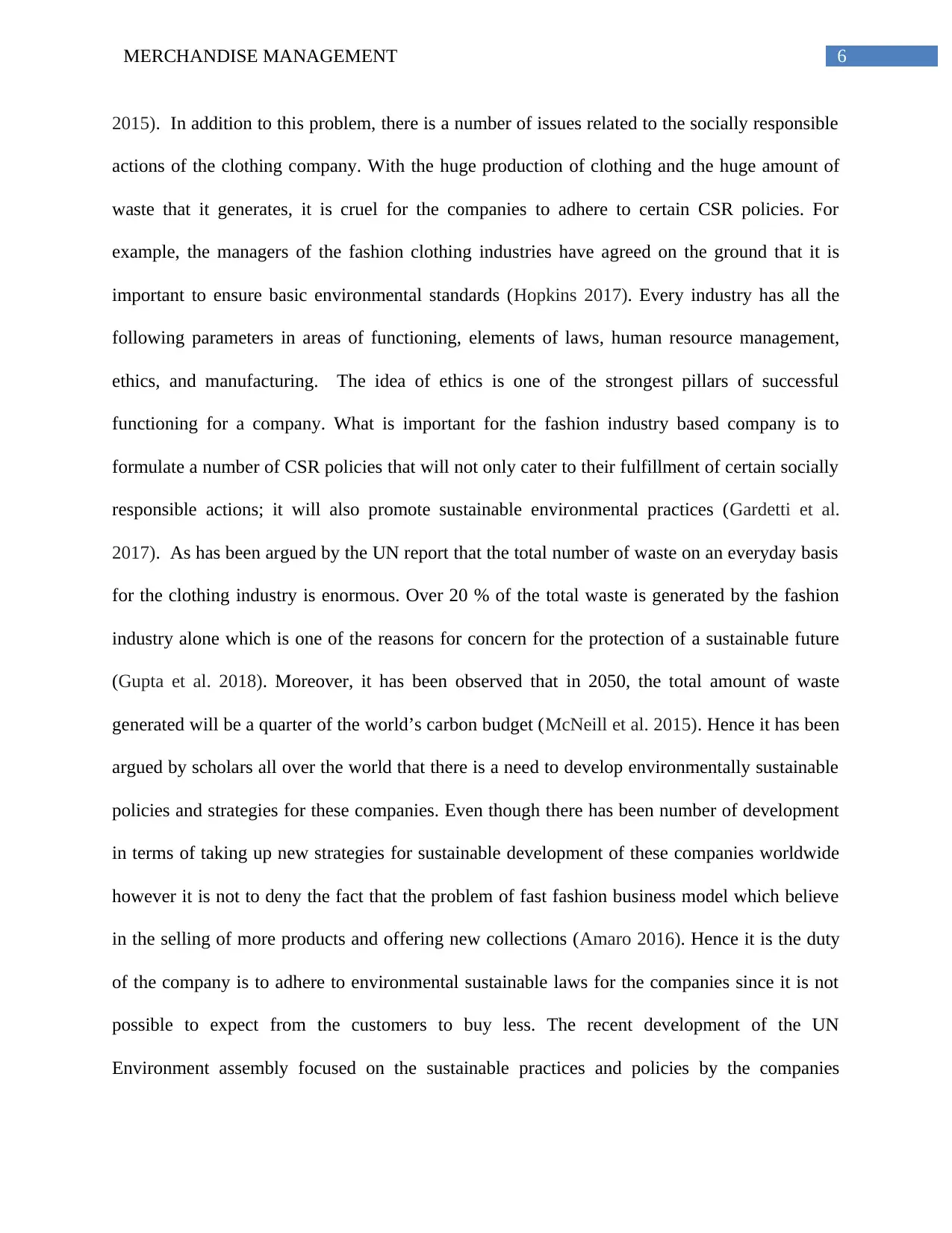
6MERCHANDISE MANAGEMENT
2015). In addition to this problem, there is a number of issues related to the socially responsible
actions of the clothing company. With the huge production of clothing and the huge amount of
waste that it generates, it is cruel for the companies to adhere to certain CSR policies. For
example, the managers of the fashion clothing industries have agreed on the ground that it is
important to ensure basic environmental standards (Hopkins 2017). Every industry has all the
following parameters in areas of functioning, elements of laws, human resource management,
ethics, and manufacturing. The idea of ethics is one of the strongest pillars of successful
functioning for a company. What is important for the fashion industry based company is to
formulate a number of CSR policies that will not only cater to their fulfillment of certain socially
responsible actions; it will also promote sustainable environmental practices (Gardetti et al.
2017). As has been argued by the UN report that the total number of waste on an everyday basis
for the clothing industry is enormous. Over 20 % of the total waste is generated by the fashion
industry alone which is one of the reasons for concern for the protection of a sustainable future
(Gupta et al. 2018). Moreover, it has been observed that in 2050, the total amount of waste
generated will be a quarter of the world’s carbon budget (McNeill et al. 2015). Hence it has been
argued by scholars all over the world that there is a need to develop environmentally sustainable
policies and strategies for these companies. Even though there has been number of development
in terms of taking up new strategies for sustainable development of these companies worldwide
however it is not to deny the fact that the problem of fast fashion business model which believe
in the selling of more products and offering new collections (Amaro 2016). Hence it is the duty
of the company is to adhere to environmental sustainable laws for the companies since it is not
possible to expect from the customers to buy less. The recent development of the UN
Environment assembly focused on the sustainable practices and policies by the companies
2015). In addition to this problem, there is a number of issues related to the socially responsible
actions of the clothing company. With the huge production of clothing and the huge amount of
waste that it generates, it is cruel for the companies to adhere to certain CSR policies. For
example, the managers of the fashion clothing industries have agreed on the ground that it is
important to ensure basic environmental standards (Hopkins 2017). Every industry has all the
following parameters in areas of functioning, elements of laws, human resource management,
ethics, and manufacturing. The idea of ethics is one of the strongest pillars of successful
functioning for a company. What is important for the fashion industry based company is to
formulate a number of CSR policies that will not only cater to their fulfillment of certain socially
responsible actions; it will also promote sustainable environmental practices (Gardetti et al.
2017). As has been argued by the UN report that the total number of waste on an everyday basis
for the clothing industry is enormous. Over 20 % of the total waste is generated by the fashion
industry alone which is one of the reasons for concern for the protection of a sustainable future
(Gupta et al. 2018). Moreover, it has been observed that in 2050, the total amount of waste
generated will be a quarter of the world’s carbon budget (McNeill et al. 2015). Hence it has been
argued by scholars all over the world that there is a need to develop environmentally sustainable
policies and strategies for these companies. Even though there has been number of development
in terms of taking up new strategies for sustainable development of these companies worldwide
however it is not to deny the fact that the problem of fast fashion business model which believe
in the selling of more products and offering new collections (Amaro 2016). Hence it is the duty
of the company is to adhere to environmental sustainable laws for the companies since it is not
possible to expect from the customers to buy less. The recent development of the UN
Environment assembly focused on the sustainable practices and policies by the companies
Paraphrase This Document
Need a fresh take? Get an instant paraphrase of this document with our AI Paraphraser
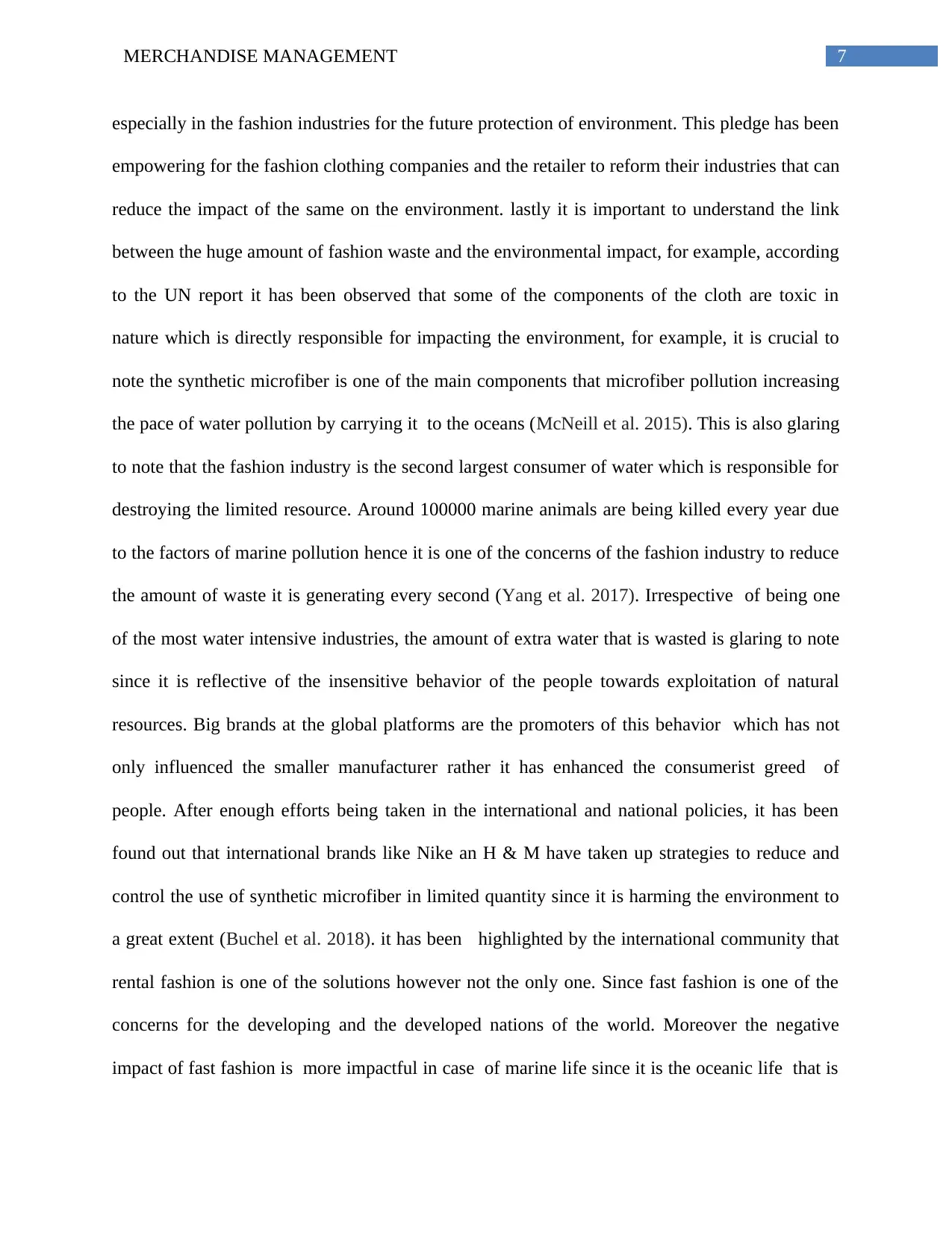
7MERCHANDISE MANAGEMENT
especially in the fashion industries for the future protection of environment. This pledge has been
empowering for the fashion clothing companies and the retailer to reform their industries that can
reduce the impact of the same on the environment. lastly it is important to understand the link
between the huge amount of fashion waste and the environmental impact, for example, according
to the UN report it has been observed that some of the components of the cloth are toxic in
nature which is directly responsible for impacting the environment, for example, it is crucial to
note the synthetic microfiber is one of the main components that microfiber pollution increasing
the pace of water pollution by carrying it to the oceans (McNeill et al. 2015). This is also glaring
to note that the fashion industry is the second largest consumer of water which is responsible for
destroying the limited resource. Around 100000 marine animals are being killed every year due
to the factors of marine pollution hence it is one of the concerns of the fashion industry to reduce
the amount of waste it is generating every second (Yang et al. 2017). Irrespective of being one
of the most water intensive industries, the amount of extra water that is wasted is glaring to note
since it is reflective of the insensitive behavior of the people towards exploitation of natural
resources. Big brands at the global platforms are the promoters of this behavior which has not
only influenced the smaller manufacturer rather it has enhanced the consumerist greed of
people. After enough efforts being taken in the international and national policies, it has been
found out that international brands like Nike an H & M have taken up strategies to reduce and
control the use of synthetic microfiber in limited quantity since it is harming the environment to
a great extent (Buchel et al. 2018). it has been highlighted by the international community that
rental fashion is one of the solutions however not the only one. Since fast fashion is one of the
concerns for the developing and the developed nations of the world. Moreover the negative
impact of fast fashion is more impactful in case of marine life since it is the oceanic life that is
especially in the fashion industries for the future protection of environment. This pledge has been
empowering for the fashion clothing companies and the retailer to reform their industries that can
reduce the impact of the same on the environment. lastly it is important to understand the link
between the huge amount of fashion waste and the environmental impact, for example, according
to the UN report it has been observed that some of the components of the cloth are toxic in
nature which is directly responsible for impacting the environment, for example, it is crucial to
note the synthetic microfiber is one of the main components that microfiber pollution increasing
the pace of water pollution by carrying it to the oceans (McNeill et al. 2015). This is also glaring
to note that the fashion industry is the second largest consumer of water which is responsible for
destroying the limited resource. Around 100000 marine animals are being killed every year due
to the factors of marine pollution hence it is one of the concerns of the fashion industry to reduce
the amount of waste it is generating every second (Yang et al. 2017). Irrespective of being one
of the most water intensive industries, the amount of extra water that is wasted is glaring to note
since it is reflective of the insensitive behavior of the people towards exploitation of natural
resources. Big brands at the global platforms are the promoters of this behavior which has not
only influenced the smaller manufacturer rather it has enhanced the consumerist greed of
people. After enough efforts being taken in the international and national policies, it has been
found out that international brands like Nike an H & M have taken up strategies to reduce and
control the use of synthetic microfiber in limited quantity since it is harming the environment to
a great extent (Buchel et al. 2018). it has been highlighted by the international community that
rental fashion is one of the solutions however not the only one. Since fast fashion is one of the
concerns for the developing and the developed nations of the world. Moreover the negative
impact of fast fashion is more impactful in case of marine life since it is the oceanic life that is
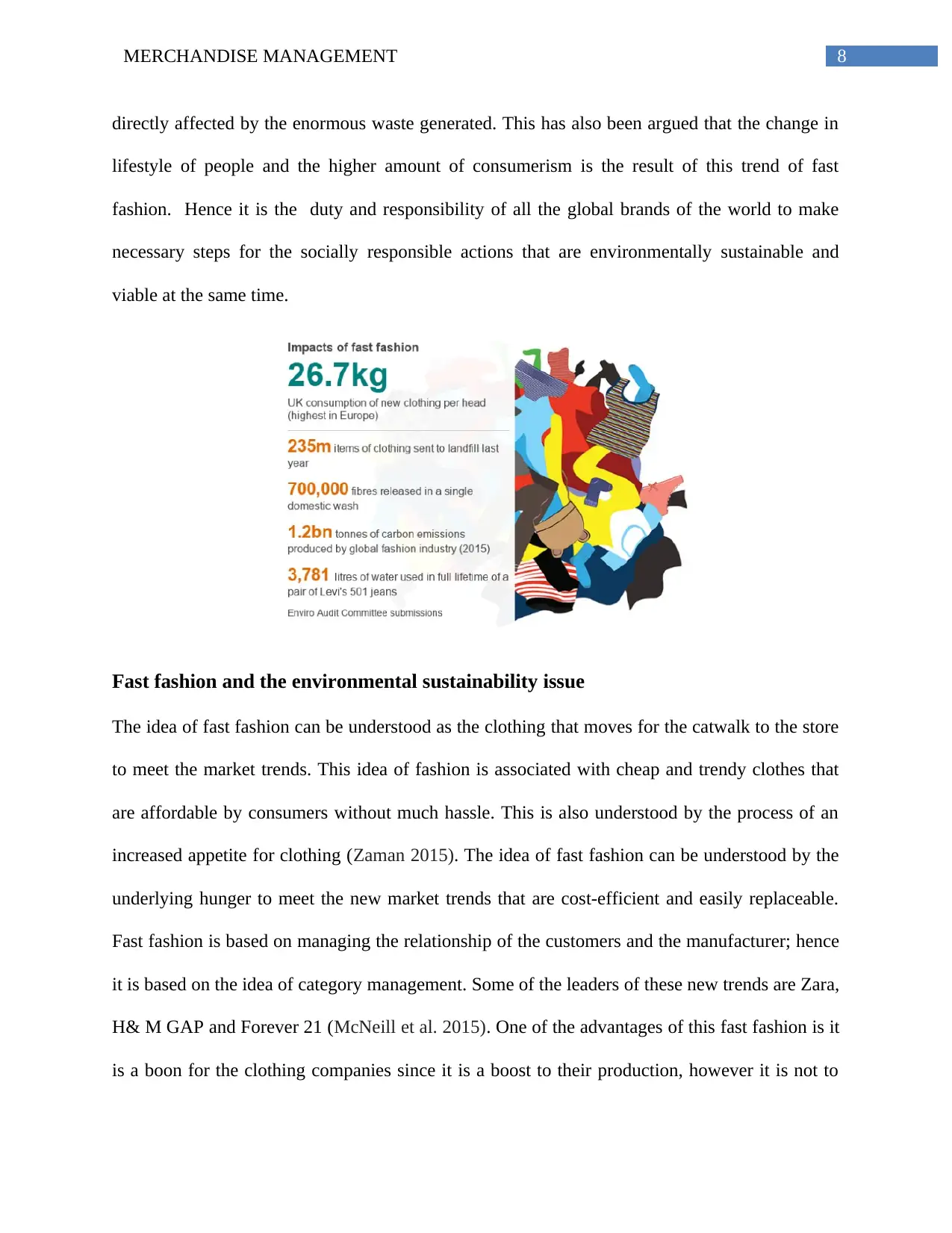
8MERCHANDISE MANAGEMENT
directly affected by the enormous waste generated. This has also been argued that the change in
lifestyle of people and the higher amount of consumerism is the result of this trend of fast
fashion. Hence it is the duty and responsibility of all the global brands of the world to make
necessary steps for the socially responsible actions that are environmentally sustainable and
viable at the same time.
Fast fashion and the environmental sustainability issue
The idea of fast fashion can be understood as the clothing that moves for the catwalk to the store
to meet the market trends. This idea of fashion is associated with cheap and trendy clothes that
are affordable by consumers without much hassle. This is also understood by the process of an
increased appetite for clothing (Zaman 2015). The idea of fast fashion can be understood by the
underlying hunger to meet the new market trends that are cost-efficient and easily replaceable.
Fast fashion is based on managing the relationship of the customers and the manufacturer; hence
it is based on the idea of category management. Some of the leaders of these new trends are Zara,
H& M GAP and Forever 21 (McNeill et al. 2015). One of the advantages of this fast fashion is it
is a boon for the clothing companies since it is a boost to their production, however it is not to
directly affected by the enormous waste generated. This has also been argued that the change in
lifestyle of people and the higher amount of consumerism is the result of this trend of fast
fashion. Hence it is the duty and responsibility of all the global brands of the world to make
necessary steps for the socially responsible actions that are environmentally sustainable and
viable at the same time.
Fast fashion and the environmental sustainability issue
The idea of fast fashion can be understood as the clothing that moves for the catwalk to the store
to meet the market trends. This idea of fashion is associated with cheap and trendy clothes that
are affordable by consumers without much hassle. This is also understood by the process of an
increased appetite for clothing (Zaman 2015). The idea of fast fashion can be understood by the
underlying hunger to meet the new market trends that are cost-efficient and easily replaceable.
Fast fashion is based on managing the relationship of the customers and the manufacturer; hence
it is based on the idea of category management. Some of the leaders of these new trends are Zara,
H& M GAP and Forever 21 (McNeill et al. 2015). One of the advantages of this fast fashion is it
is a boon for the clothing companies since it is a boost to their production, however it is not to
⊘ This is a preview!⊘
Do you want full access?
Subscribe today to unlock all pages.

Trusted by 1+ million students worldwide
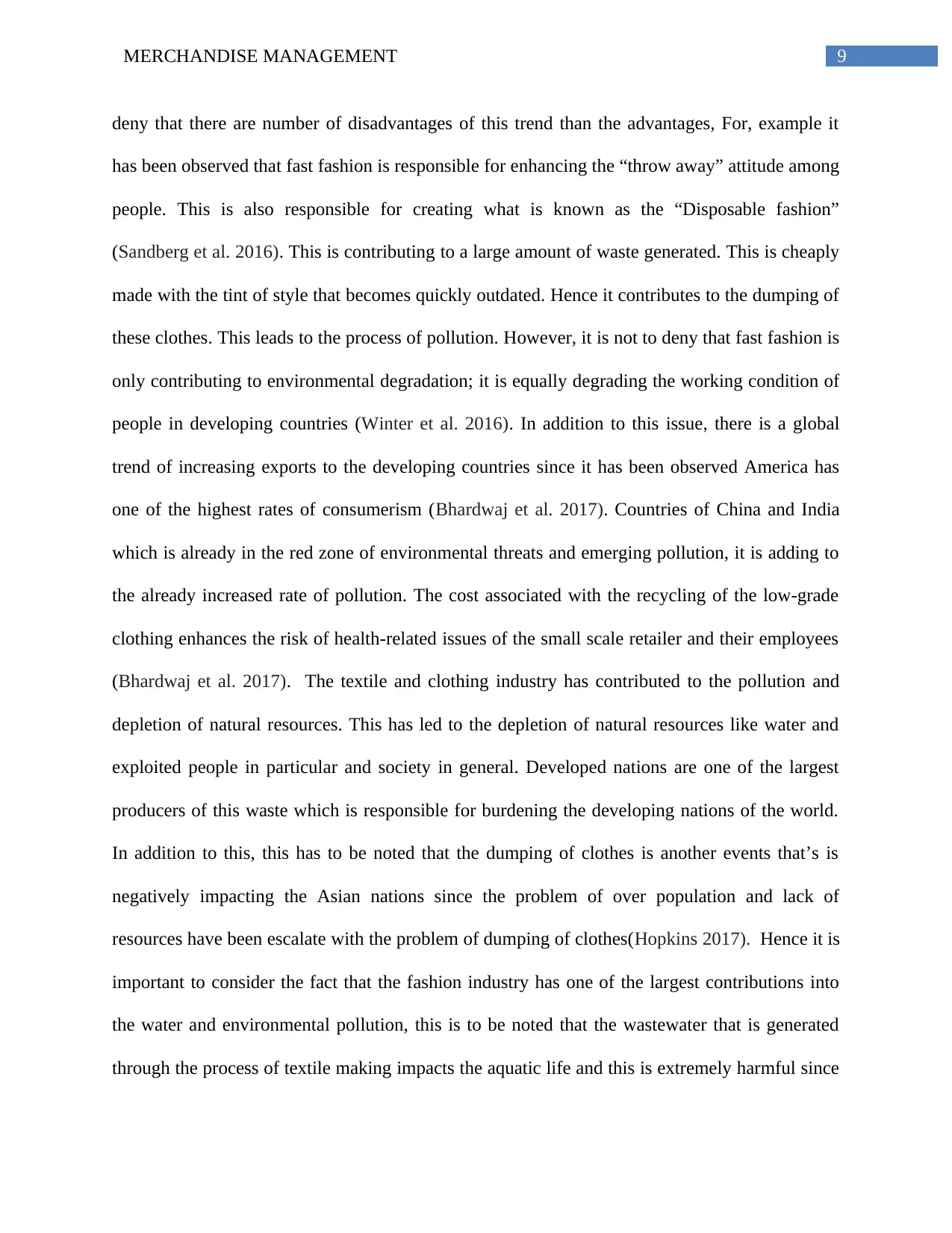
9MERCHANDISE MANAGEMENT
deny that there are number of disadvantages of this trend than the advantages, For, example it
has been observed that fast fashion is responsible for enhancing the “throw away” attitude among
people. This is also responsible for creating what is known as the “Disposable fashion”
(Sandberg et al. 2016). This is contributing to a large amount of waste generated. This is cheaply
made with the tint of style that becomes quickly outdated. Hence it contributes to the dumping of
these clothes. This leads to the process of pollution. However, it is not to deny that fast fashion is
only contributing to environmental degradation; it is equally degrading the working condition of
people in developing countries (Winter et al. 2016). In addition to this issue, there is a global
trend of increasing exports to the developing countries since it has been observed America has
one of the highest rates of consumerism (Bhardwaj et al. 2017). Countries of China and India
which is already in the red zone of environmental threats and emerging pollution, it is adding to
the already increased rate of pollution. The cost associated with the recycling of the low-grade
clothing enhances the risk of health-related issues of the small scale retailer and their employees
(Bhardwaj et al. 2017). The textile and clothing industry has contributed to the pollution and
depletion of natural resources. This has led to the depletion of natural resources like water and
exploited people in particular and society in general. Developed nations are one of the largest
producers of this waste which is responsible for burdening the developing nations of the world.
In addition to this, this has to be noted that the dumping of clothes is another events that’s is
negatively impacting the Asian nations since the problem of over population and lack of
resources have been escalate with the problem of dumping of clothes(Hopkins 2017). Hence it is
important to consider the fact that the fashion industry has one of the largest contributions into
the water and environmental pollution, this is to be noted that the wastewater that is generated
through the process of textile making impacts the aquatic life and this is extremely harmful since
deny that there are number of disadvantages of this trend than the advantages, For, example it
has been observed that fast fashion is responsible for enhancing the “throw away” attitude among
people. This is also responsible for creating what is known as the “Disposable fashion”
(Sandberg et al. 2016). This is contributing to a large amount of waste generated. This is cheaply
made with the tint of style that becomes quickly outdated. Hence it contributes to the dumping of
these clothes. This leads to the process of pollution. However, it is not to deny that fast fashion is
only contributing to environmental degradation; it is equally degrading the working condition of
people in developing countries (Winter et al. 2016). In addition to this issue, there is a global
trend of increasing exports to the developing countries since it has been observed America has
one of the highest rates of consumerism (Bhardwaj et al. 2017). Countries of China and India
which is already in the red zone of environmental threats and emerging pollution, it is adding to
the already increased rate of pollution. The cost associated with the recycling of the low-grade
clothing enhances the risk of health-related issues of the small scale retailer and their employees
(Bhardwaj et al. 2017). The textile and clothing industry has contributed to the pollution and
depletion of natural resources. This has led to the depletion of natural resources like water and
exploited people in particular and society in general. Developed nations are one of the largest
producers of this waste which is responsible for burdening the developing nations of the world.
In addition to this, this has to be noted that the dumping of clothes is another events that’s is
negatively impacting the Asian nations since the problem of over population and lack of
resources have been escalate with the problem of dumping of clothes(Hopkins 2017). Hence it is
important to consider the fact that the fashion industry has one of the largest contributions into
the water and environmental pollution, this is to be noted that the wastewater that is generated
through the process of textile making impacts the aquatic life and this is extremely harmful since
Paraphrase This Document
Need a fresh take? Get an instant paraphrase of this document with our AI Paraphraser
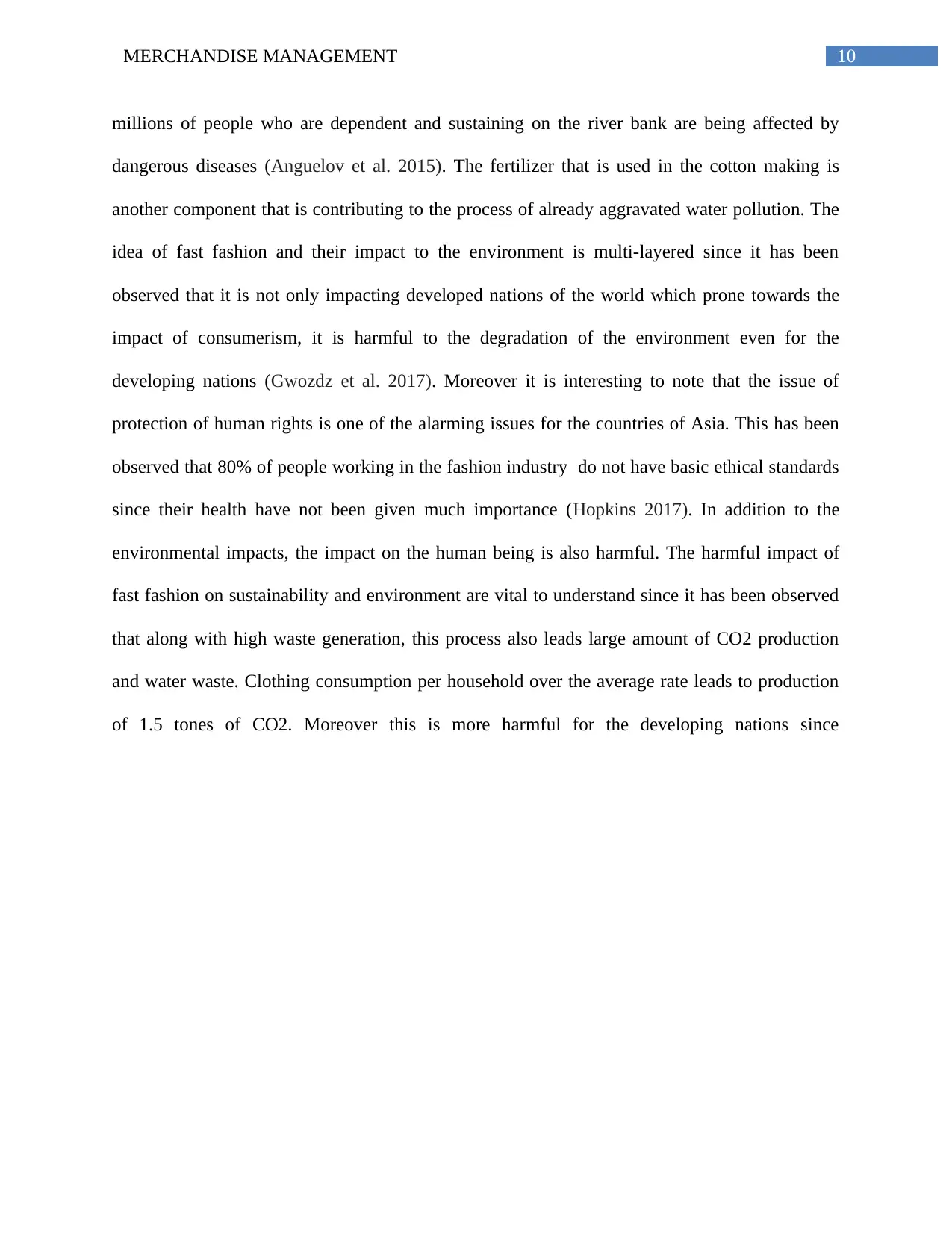
10MERCHANDISE MANAGEMENT
millions of people who are dependent and sustaining on the river bank are being affected by
dangerous diseases (Anguelov et al. 2015). The fertilizer that is used in the cotton making is
another component that is contributing to the process of already aggravated water pollution. The
idea of fast fashion and their impact to the environment is multi-layered since it has been
observed that it is not only impacting developed nations of the world which prone towards the
impact of consumerism, it is harmful to the degradation of the environment even for the
developing nations (Gwozdz et al. 2017). Moreover it is interesting to note that the issue of
protection of human rights is one of the alarming issues for the countries of Asia. This has been
observed that 80% of people working in the fashion industry do not have basic ethical standards
since their health have not been given much importance (Hopkins 2017). In addition to the
environmental impacts, the impact on the human being is also harmful. The harmful impact of
fast fashion on sustainability and environment are vital to understand since it has been observed
that along with high waste generation, this process also leads large amount of CO2 production
and water waste. Clothing consumption per household over the average rate leads to production
of 1.5 tones of CO2. Moreover this is more harmful for the developing nations since
millions of people who are dependent and sustaining on the river bank are being affected by
dangerous diseases (Anguelov et al. 2015). The fertilizer that is used in the cotton making is
another component that is contributing to the process of already aggravated water pollution. The
idea of fast fashion and their impact to the environment is multi-layered since it has been
observed that it is not only impacting developed nations of the world which prone towards the
impact of consumerism, it is harmful to the degradation of the environment even for the
developing nations (Gwozdz et al. 2017). Moreover it is interesting to note that the issue of
protection of human rights is one of the alarming issues for the countries of Asia. This has been
observed that 80% of people working in the fashion industry do not have basic ethical standards
since their health have not been given much importance (Hopkins 2017). In addition to the
environmental impacts, the impact on the human being is also harmful. The harmful impact of
fast fashion on sustainability and environment are vital to understand since it has been observed
that along with high waste generation, this process also leads large amount of CO2 production
and water waste. Clothing consumption per household over the average rate leads to production
of 1.5 tones of CO2. Moreover this is more harmful for the developing nations since
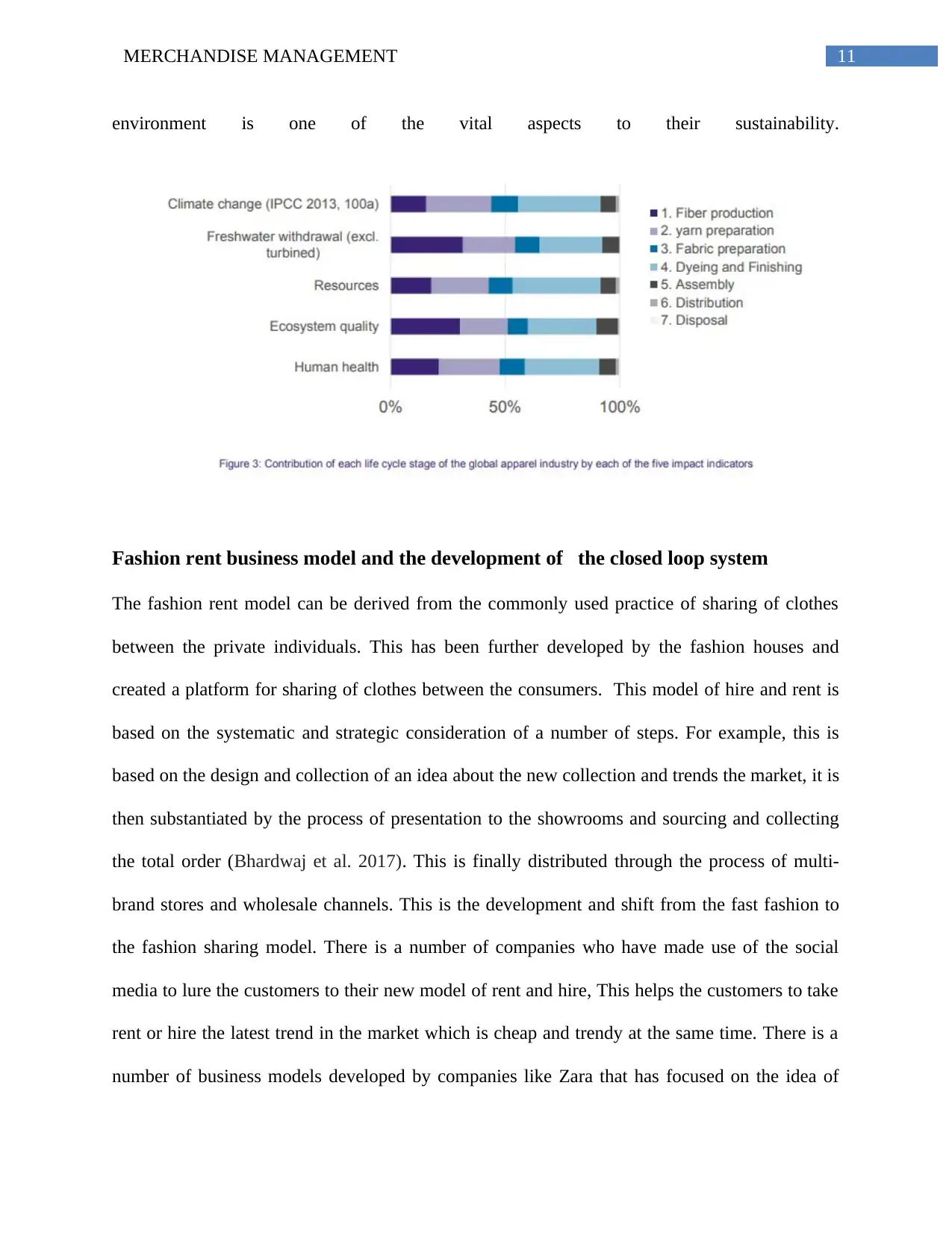
11MERCHANDISE MANAGEMENT
environment is one of the vital aspects to their sustainability.
Fashion rent business model and the development of the closed loop system
The fashion rent model can be derived from the commonly used practice of sharing of clothes
between the private individuals. This has been further developed by the fashion houses and
created a platform for sharing of clothes between the consumers. This model of hire and rent is
based on the systematic and strategic consideration of a number of steps. For example, this is
based on the design and collection of an idea about the new collection and trends the market, it is
then substantiated by the process of presentation to the showrooms and sourcing and collecting
the total order (Bhardwaj et al. 2017). This is finally distributed through the process of multi-
brand stores and wholesale channels. This is the development and shift from the fast fashion to
the fashion sharing model. There is a number of companies who have made use of the social
media to lure the customers to their new model of rent and hire, This helps the customers to take
rent or hire the latest trend in the market which is cheap and trendy at the same time. There is a
number of business models developed by companies like Zara that has focused on the idea of
environment is one of the vital aspects to their sustainability.
Fashion rent business model and the development of the closed loop system
The fashion rent model can be derived from the commonly used practice of sharing of clothes
between the private individuals. This has been further developed by the fashion houses and
created a platform for sharing of clothes between the consumers. This model of hire and rent is
based on the systematic and strategic consideration of a number of steps. For example, this is
based on the design and collection of an idea about the new collection and trends the market, it is
then substantiated by the process of presentation to the showrooms and sourcing and collecting
the total order (Bhardwaj et al. 2017). This is finally distributed through the process of multi-
brand stores and wholesale channels. This is the development and shift from the fast fashion to
the fashion sharing model. There is a number of companies who have made use of the social
media to lure the customers to their new model of rent and hire, This helps the customers to take
rent or hire the latest trend in the market which is cheap and trendy at the same time. There is a
number of business models developed by companies like Zara that has focused on the idea of
⊘ This is a preview!⊘
Do you want full access?
Subscribe today to unlock all pages.

Trusted by 1+ million students worldwide
1 out of 22
Related Documents
Your All-in-One AI-Powered Toolkit for Academic Success.
+13062052269
info@desklib.com
Available 24*7 on WhatsApp / Email
![[object Object]](/_next/static/media/star-bottom.7253800d.svg)
Unlock your academic potential
Copyright © 2020–2025 A2Z Services. All Rights Reserved. Developed and managed by ZUCOL.




